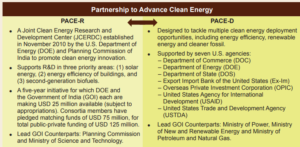In news : Both India and USA have agreed to revamp India-US Strategic Energy Partnership
Key updates
- Minister of Petroleum and Natural Gas & Steel recently held an introductory meeting virtually with US Secretary of Energy
- Both leaders agreed to revamp the India-US SEP to reflect the new priorities of Prime Minister Narendra Modi and President Joe Biden with focus on promoting clean energy with low-carbon pathways and accelerating green energy cooperation.
- They agreed to prioritise greater collaboration in cleaner energy sector- biofuels, CCUS, hydrogen production and carbon sequestration through technology exchange, joint R&D through Partnership to Advance Clean Energy Research (PACE-R), among other initiatives.4
- Both sides agreed to convene the third meeting of a revamped India-US Strategic Energy Partnership at an early date.
- They decided to intensify the efforts to take advantage of the complementarities of both the countries -advanced US technologies and rapidly growing India’s energy market, for a win-win situation through a cleaner energy route with low carbon pathways.
Previous SEPs
- Earlier, two SEPs were held under the Trump Administration, where the focus of energy cooperation was more on supply of fossil fuels from America rather than cooperation in reducing carbon footprints.
- While the import of fossil fuel from the US will continue, Washington will support India’s efforts for clean energy
- The inaugural SEP, a ministerial meeting, was first held on April 17, 2018. Its second meeting took place on July 17, 2020.
Partnership to Advance Clean Energy Research (PACE)
- Partnership to Advance Clean Energy (PACE) is the flagship program on clean energy between the U.S. and India to jointly work on a range of issues related to energy security, clean energy and climate change.
- It seeks to accelerate inclusive, low-carbon growth by supporting research and deployment of clean energy technologies and policies.
- PACE combines the efforts of several government and nongovernment stakeholders on both the U.S. and Indian sides and includes three key components:
- Research (PACE-R)
- Deployment (PACE-D), and
- Off-Grid Energy Access (PEACE).
- PACE-D includes a USD 20 million five-year technical assistance (TA) program which is led by the U.S. Agency for International Development (USAID) and the U.S. Department of State and implemented in partnership with the Ministry of Power (MOP) and the Ministry of New and Renewable Energy (MNRE).

















